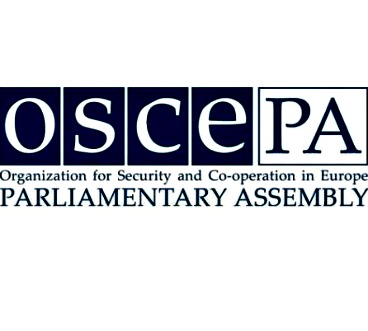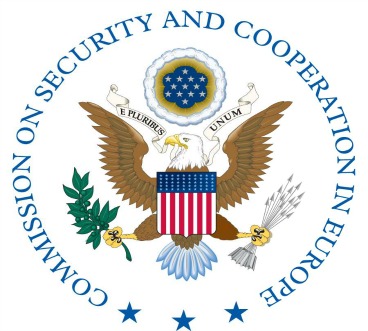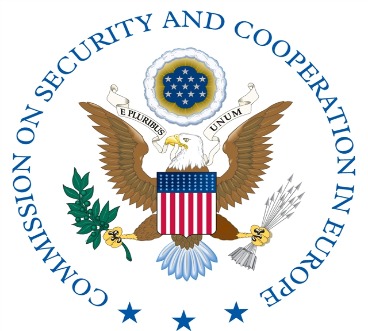The U.S. Helsinki Commission convened the hearing, “The State of Diversity and Inclusion in Europe: Race, Rights, and Politics” one week ahead of the OSCE’s annual Human Dimension Implementation Meeting (HDIM), which included a focus on hate crimes and Roma populations, and the European Union’s first ever Anti-Racism and Diversity Week held in the European Parliament.
Helsinki Commissioner Representative Gwen Moore (WI-04) chaired the hearing and was joined by Helsinki Commissioners: Chairman Alcee L. Hastings (FL-20), Rep. Steve Cohen (TN-09), Rep. Emanuel Cleaver, II (MO-05), and Rep. Marc Veasey (TX-33). Against the backdrop of recent European elections that included numerous xenophobic political parties, Chairman Hastings highlighted the importance of the hearing given the rise in prejudice and xenophobic violence in both Europe and in the United States including from far-right extremists.
Rep. Moore reiterated the necessity of the hearing given “numerous reports from Europe of hate crimes and acts of extremism, racial profiling in cities and at borders, and discrimination at work and in the schools, with the OSCE reporting close to 6,000 hate crimes in the region over the last year, and a recent European parliamentary study concluding that people from ethnic or racial minorities in the EU experience higher risks of economic hardship, poorer-quality housing, residential segregation, unemployment, and assault.”
She also raised concerns regarding Americans being impacted by disparate treatment and related violence in Europe, following reports that U.S. military personnel and diplomats serving in Europe, students studying abroad, and tourists have been the targets of discrimination, including hate crimes.
Panel 1
The first panel consisted of Members of the European Parliament who lead the Anti-Racism and Diversity Intergroup: MEP Romeo Franz (Germany), MEP Dr. Pierrette Herzberger-Fofana (Germany), MEP Evin Incir (Sweden), MEP Samira Rafaela (Netherlands), and Coordinator Alfiaz Vaiya of the Intergroup.
MEP Dr. Herzberger-Fofana described how Afro-German victims are often excluded from the discourse on Nazis and the Holocaust, and the need for recognition and restitution, stating, “We owe more to our ancestors than to allow their memories and sacrifices to be erased from the common conscious.”
MEP Franz stated that despite the adoption of anti-discrimination legislation by all EU states, 80 percent of the Roma community lives below their respective country’s poverty line due to anti-gypsyism and institutionalized racism.
“Europe was based on that fundamental belief that all people are born equal, regardless the color of the skin, religion, or ethnicity. And that is what must be defended and promoted by its leaders,” said MEP Franz.
MEP Incir called for those who believe in equal, democratic societies to stand together to counter global nationalist movements being led by right-wing extremist organizations, while MEP Rafaela discussed the importance of representative politics in preserving democracies and the need to address current tensions in the transatlantic relationship.
Mr. Vaiya concluded the first panel, stating, “In a majority of the 28 [EU] member states, we see far-right political parties in government [and] working with the current U.S. administration and other far-right political parties and leaders across the world.” Mr. Vaiya went on to say, “Jewish people, whether it’s Muslims, whether it’s LGBTI people, whether it’s people who are Roma or black […] The shared threat is the same. It’s the populism, it’s the racism, it’s the fascism. It may be specific to each individual community, but we have to understand that threat is together.”
Panel 2
The second panel consisted of Councilor Irene Appiah (Hamburg, Germany), Vice-Chair Domenica Ghidei Biidu (Netherlands) of the European Commission Against Racism and Intolerance (ECRI), and MPs Olivier Serva and Daniele Obono (France).
Vice-Chair Biidu recognized the U.S. as a partner and peer in combating racism and intolerance and urged the U.S. to engage in counter-populistic rhetoric and hate speech, foster constructive and peaceful relationships with Muslim countries and between Muslim countries and Israel, assist in the fight against anti-Semitism, safeguard irregular migrants, and seek observer status in the plenary meeting of ECRI.
Remarking on the vibrant Afro-descent population in Germany, Councilor Appiah called for Germany and other countries to provide statistical data on minorities and the African diaspora to assist in the fight against racism. In discussing French diversity resulting from colonialism and African enslavement, MP Obono highlighted the need for statistics on race to address continuing racial disparities. In addressing continuing disparities between French territories in the Caribbean and France, MP Serva called for teaching of the history of slavery in the French overseas territories, increasing minorities in French media, equality data, and addressing brain drain in the territories.
Other points discussed included complacency from both left and right parties in protecting western democracies, Russian exploitation of societal divisions, including utilizing racial prejudice, to disrupt democracy, and the need to strengthen efforts to address online hate while protecting free speech.
Witnesses also participated in meetings and other events during the week, such as the Transatlantic Minority Political Leadership Conference.





